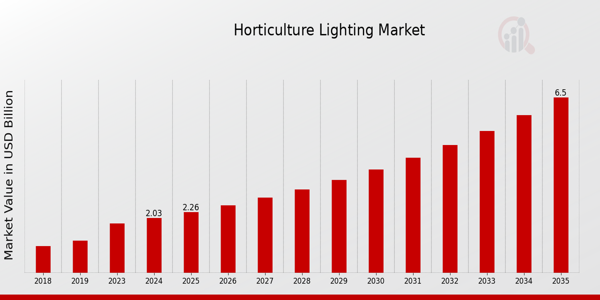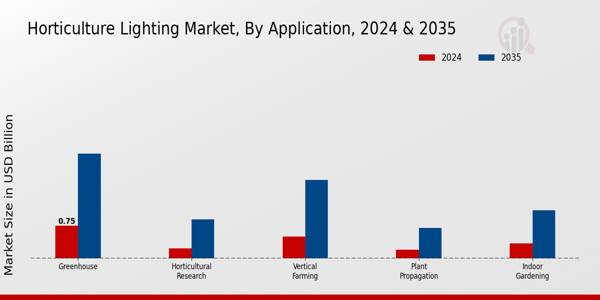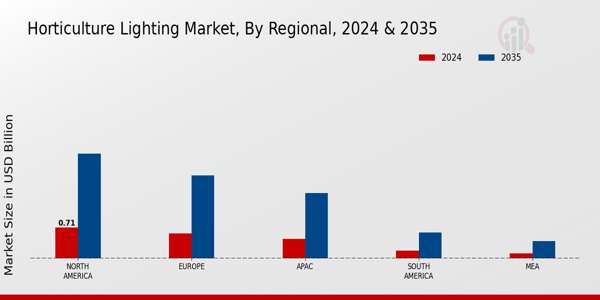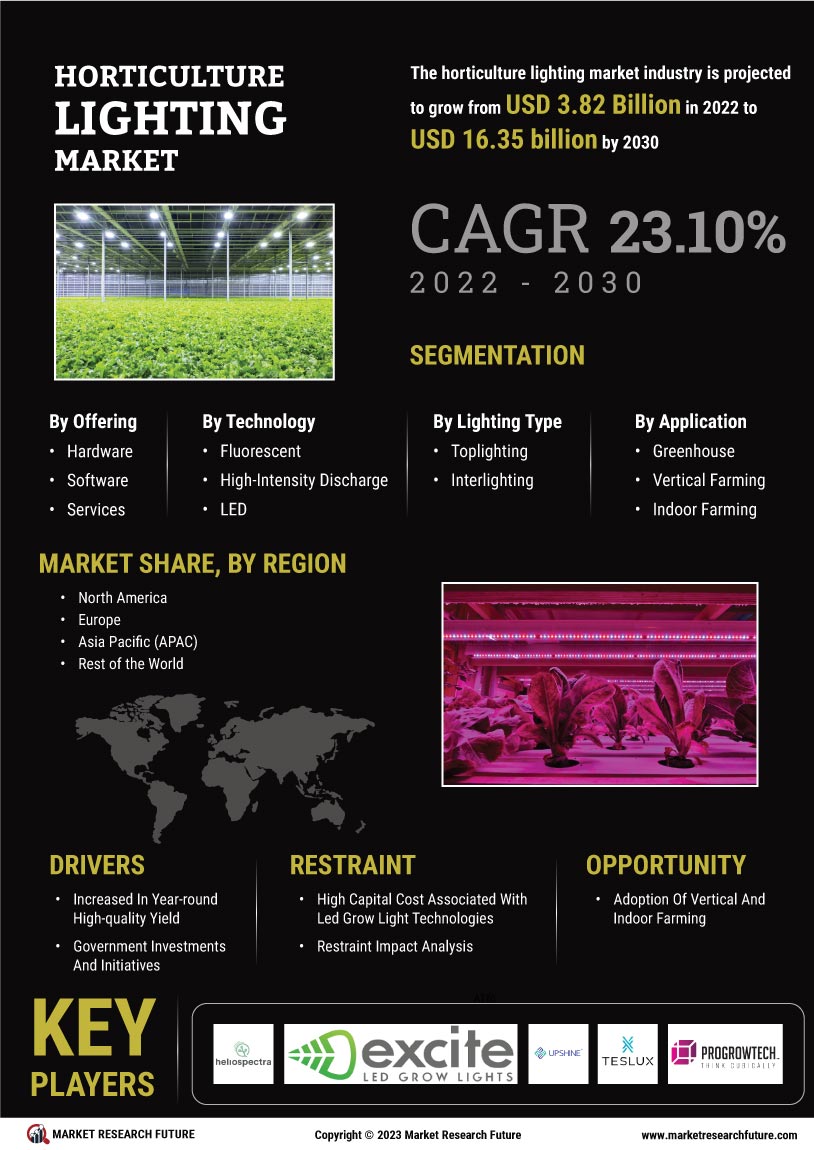Horticulture Lighting Market Summary
As per Market Research Future Analysis, the Horticulture Lighting Market was valued at 1.83 USD Billion in 2023 and is projected to reach 6.5 USD Billion by 2035, growing at a CAGR of 11.16% from 2025 to 2035. The market is driven by the increasing demand for energy-efficient lighting solutions, particularly LED technology, and the rise of indoor farming and urban agriculture. Government initiatives supporting sustainable practices further enhance market growth, while advancements in lighting technology and smart systems present new opportunities.
Key Market Trends & Highlights
The Horticulture Lighting Market is witnessing transformative trends driven by sustainability and technological advancements.
- The market is expected to grow from 2.03 USD Billion in 2024 to 6.5 USD Billion by 2035.
- Greenhouse lighting is projected to increase from 0.75 USD Billion in 2024 to 2.4 USD Billion by 2035.
- LED technology is anticipated to lead the market due to its energy efficiency, with potential energy savings of up to 75%.
- The global indoor agriculture market is projected to reach approximately 19.9 USD Billion by 2027.
Market Size & Forecast
2023 Market Size: USD 1.83 Billion
2024 Market Size: USD 2.03 Billion
2035 Market Size: USD 6.5 Billion
CAGR (2025-2035): 11.16%
Largest Regional Market Share in 2024: North America.
Major Players
Key players include Castor, Netled, Osram, Philips, GE Current, and Signify.
Key Horticulture Lighting Market Trends Highlighted
Growing urbanization and a growing need for fresh food are driving the Horticulture Lighting Market's notable expansion. The need for effective indoor and vertical farming solutions grows as more people move into cities, which increases the requirement for sophisticated horticulture lighting systems.
In addition to increasing agricultural output, these systems aid in energy optimization, which is crucial for achieving the sustainability targets established by governments throughout the globe. This industry is also expanding as a result of increased knowledge of the advantages of LED lighting in agriculture.
The development of intelligent lighting systems for horticulture that can be integrated with Internet of Things (IoT) technology presents several opportunities. These devices make it easier for producers to boost output while cutting waste by enabling real-time monitoring and control of light, temperature, and moisture levels.
Improvements in light spectrum technology also provide producers with the ability to optimize their yield by adjusting lighting settings for different plant types. The need for specialist horticulture lighting is further fueled by recent trends showing a shift toward organic and hydroponic growing methods.
High-quality, pesticide-free food is becoming more and more in demand as people get more ecologically concerned and health-conscious. Furthermore, governments everywhere are supporting indoor farming projects because they see the opportunity for local food production and employment development.
These patterns highlight the need for innovation and sustainability in agricultural methods and indicate a changing environment in the horticulture lighting industry.

Source: Primary Research, Secondary Research, MRFR Database and Analyst Review
Horticulture Lighting Market Drivers
Increased Adoption of Indoor Farming Techniques
The Horticulture Lighting Market is witnessing a surge due to the growing popularity of indoor farming techniques driven by urbanization. The United Nations estimates that by 2050, nearly 68% of the global population will live in urban areas, creating a significant demand for local food production.
According to a report from the Food and Agriculture Organization, indoor farming can produce crops year-round with significantly higher yields compared to traditional methods.
This shift towards urban indoor farming not only alleviates food scarcity but also enhances the quality and freshness of produce, encouraging further investment in advanced horticulture lighting solutions. Established organizations, such as the International Society for Horticultural Science, advocate for these methods, highlighting the need for sophisticated lighting systems to optimize growth conditions.
Government Support and Initiatives
Government policies aimed at boosting agricultural efficiency are a significant driver for the Horticulture Lighting Market. Various countries are rolling out incentives and subsidies for innovative gardening solutions.
For example, the European Union has been known to implement directives that support sustainable agricultural practices, including the use of advanced lighting technologies for horticulture. In the United States, the Department of Agriculture has introduced programs to help farmers access funding for energy-efficient technologies.
According to reports, government investment in horticultural advancements increased by approximately 15% from 2020 to 2022, fostering an environment conducive to horticulture lighting advancements.
Technological Advancements in Lighting Solutions
Technological improvements in LED (Light Emitting Diode) and other lighting technologies are propelling the Horticulture Lighting Market forward. Recent advancements have led to the development of highly efficient lighting systems that consume significantly less energy than traditional lighting options, with some LEDs reported to consume up to 75% less energy.
The U.S. Department of Energy indicates that such energy-efficient lighting installations can lead to substantial operational cost savings and a reduced carbon footprint. Established enterprises in the lighting industry, such as Philips Lighting and Osram, are continuously researching and developing new products that cater to the specific needs of horticulture.
Horticulture Lighting Market Segment Insights:
Horticulture Lighting Market Application Insights
The Horticulture Lighting Market focuses on various applications that cater to the growing demand for efficient lighting solutions in agricultural practices.
Among the applications, the Greenhouse sector significantly dominated the market with a valuation of 0.91 USD billion in 2024 and is projected to grow to 2.95 USD billion by 2035. This surge was driven by the need for controlled environments that maximized yield through optimized light conditions, making Greenhouse lighting a cornerstone of modern agriculture.
Vertical Farming, another crucial application, was valued at 0.52 USD billion in 2024 and is expected to reach 1.73 USD billion by 2035. Its growing significance lies in urban agriculture, where space is limited, allowing for greater food production per square foot through advanced lighting systems.
Indoor Gardening represented a smaller yet notable segment, valued at 0.33 USD billion in 2024, increasing to 1.1 USD billion by 2035; this sub-segment is witnessing growth fueled by a rising trend in home gardening and the desire for fresh produce year-round.
Horticultural Research shows steady growth from 0.13 USD billion in 2024 to 0.43 USD billion in 2035, emphasizing the role of lighting systems in scientific studies aimed at enhancing crop yield and sustainability. Lastly, Plant Propagation, valued at 0.14 USD billion in 2024, is expected to grow to 0.49 USD billion by 2035, highlighting the integration of specialized lighting in nursery operations for seedlings.
The Horticulture Lighting Market is reflective of a broader trend in the agriculture industry towards sustainable practices and yield maximization, with technological advancements playing a crucial role in driving these developments.
Each application contributes uniquely to the market's growth, underlining the overall trend towards more efficient and controlled agricultural practices globally.

Source: Primary Research, Secondary Research, MRFR Database and Analyst Review
Horticulture Lighting Market Lighting Type Insights
The Horticulture Lighting Market is poised to experience considerable growth. The market segmentation within the Lighting Type category includes various technologies such as LED, High-Intensity Discharge, Fluorescent, Incandescent, and Laser.
LED lighting is a significant player in this market, recognized for its energy efficiency and long lifespan, making it a preferred choice for commercial growers and indoor farming applications. High-Intensity Discharge lighting also holds a substantial position due to its ability to provide intense light and broad-spectrum output, essential for optimal plant growth.
Fluorescent lighting continues to be utilized for its cost-effectiveness, especially in smaller setups, whereas traditional Incandescent lighting has seen a decline in use due to energy efficiency concerns. The emergence of Laser-based horticultural lighting represents an innovative and niche area that offers precise wavelength control for specific plant requirements.
As the horticulture sector globally seeks sustainable and energy-efficient solutions, these technologies are positioned to meet the growing demand, contributing to the overall market dynamics and revenue growth observed within the Horticulture Lighting Market.
Horticulture Lighting Market Light Spectrum Insights
The Horticulture Lighting Market exhibits remarkable growth within the Light Spectrum segment, which is anticipated to play a critical role in enhancing plant growth and productivity. This segment is characterized by various types of light spectra, including Full Spectrum, Red and Blue Spectrum, White Spectrum, Ultraviolet Spectrum, and Far-Red Spectrum.
Full-spectrum light, known for mimicking natural sunlight, is crucial for comprehensive plant development, making it a preferred choice among growers. Meanwhile, Red and Blue Spectrum lights are commonly used in vegetative and flowering stages, fostering photosynthesis effectively.
White Spectrum serves as a versatile option, suitable for all growth stages. Ultraviolet Spectrum has gained attention for its potential in stimulating plant protection responses, thereby increasing crop resilience, while Far-Red Spectrum is vital for controlling flowering time in certain plants.
The expanding horticulture industry, coupled with advancements in lighting technology, supports the ascending trajectory of the Horticulture Lighting Market, illuminating opportunities for sustainable and efficient agricultural practices across the globe.
Horticulture Lighting Market End Use Insights
The Horticulture Lighting Market is experiencing significant growth driven by various end-use applications, particularly among Commercial Growers, Residential Users, Research Institutions, and Agricultural Cooperatives.
Commercial Growers play a critical role within this sector, utilizing specialized horticulture lighting to enhance crop yield and reduce production cycles, thus contributing to the increased demand for efficient growing technologies.
Residential Users are also gaining traction with home gardening and indoor plant cultivation, fostering interest in energy-efficient lighting alternatives. Research Institutions are vital for the development of innovative horticulture lighting methods and technologies, advancing the industry through research and applications.
Agricultural Cooperatives leverage collective resources to implement effective lighting systems, enabling them to maximize productivity. Together, these segments are shaping the market dynamics, boosted by an increasing focus on sustainable practices and crop quality enhancement, aligning with global agricultural trends and food security initiatives.
The expected growth of these segments highlights their foundational importance in driving the overall market expansion and technological adoption within the Horticulture Lighting Market.
Horticulture Lighting Market Regional Insights
The Regional aspect of the Horticulture Lighting Market reflected a robust growth trajectory, with North America holding a significant position, valued at 0.8 USD billion in 2024 and projected to reach 2.7 USD billion by 2035, driven by advanced agricultural practices and technology adoption.
Europe followed closely with a valuation of 0.65 USD billion in 2024, expected to grow to 2.1 USD billion, as European nations increasingly focus on sustainable farming techniques and the reduction of carbon footprints.
South America, at 0.2 USD billion, and projected to reach 0.8 USD billion, presented untapped potential due to its diverse climate and agriculture dependency, although it remained a developing segment in the market.
Asia Pacific, valued at 0.3 USD billion in 2024 and anticipated to grow to 1.2 USD billion, witnessed increased investments in urban agriculture and greenhouse systems, highlighting its importance. Lastly, Middle East and Africa, represented by a smaller valuation of 0.08 USD billion, aiming to rise to 0.5 USD billion, are slowly emerging as players due to growing food security concerns.
The geographical distribution and varying growth rates across these regions showcased the Horticulture Lighting Market's potential, driven by technological advancements, rising demand for energy-efficient solutions, and a shift towards indoor farming practices.

Source: Primary Research, Secondary Research, MRFR Database and Analyst Review
Horticulture Lighting Market Key Players and Competitive Insights:
The competitive landscape of the Horticulture Lighting Market has been shaped by various innovative players and evolving technologies catering to the needs of modern agriculture and horticulture.
As the demand for sustainable and efficient growing solutions continues to grow, companies in this sector are increasingly focusing on advanced lighting systems that enhance plant growth, minimize energy consumption, and optimize resource use.
The market is characterized by a diverse range of products, including LED lights, high-intensity discharge lamps, and other specialized lighting solutions, tailored to meet the specific needs of different crops and cultivation environments.
Integrating cutting-edge technology, many firms are striving to provide comprehensive solutions, ensuring they stay ahead of the competition and meet the increasing global appetite for high-quality produce.
Agnetix has established a noteworthy presence in the Horticulture Lighting Market, primarily focusing on intelligent lighting systems that promote efficient plant growth. The company's strengths lie in its unique approach to data integration and automation in horticulture lighting, which allows growers to optimize their lighting schedules and conditions based on real-time environmental data.
Agnetix emphasizes energy efficiency and sustainability, leveraging advanced LED technology to minimize energy usage while maximizing plant yield.
With a commitment to innovation and customer-centric solutions, Agnetix has successfully positioned itself as a key player in this competitive market segment, appealing to commercial growers seeking to increase productivity while reducing operational costs.
Cree has emerged as a significant contributor to the Horticulture Lighting Market, offering a robust range of LED lighting solutions tailored for agricultural applications. The company is well-known for its high-performance lighting products, which are designed to optimize photosynthesis and crop yield.
Key products often include industry-leading LED grow lights, designed for both large-scale commercial operations and smaller greenhouse setups. Cree's strengths lie in its extensive research and development capabilities, allowing the company to introduce cutting-edge technologies that enhance the efficacy of horticultural lighting.
Furthermore, its strategic partnerships and collaborations in the market encapsulate a strong growth trajectory, fostering a comprehensive ecosystem for horticulture lighting solutions. With ongoing efforts towards mergers and acquisitions, Cree continues to strengthen its market position, aiming to remain at the forefront of innovation and excellence within the Horticulture Lighting Market.
Key Companies in the Horticulture Lighting Market Include:
Horticulture Lighting Market Developments
Agnetix was selected by AgriTech North in October 2024 to install liquid-cooled ZENITH and PHENOM IoT-enabled luminaires in its new greenhouse in Dryden, Canada. These luminaires will provide waste-heat recovery and real-time environmental monitoring.
Agnetix introduced their IP67-rated, weatherproof A3 LED grow lamp in December 2024. It is intended for vertical farms that operate in severe, temperature-controlled conditions. Agnetix secured a significant partnership with Limgroup in June 2025 for cutting-edge strawberry farming operations, utilizing sensor-driven LED modules to maximize productivity and quality.
With an effectiveness of over 2.1 µmol/J, Fluence's most recent LED horticulture lighting systems, including SPYDR, VYPR, RAZR, and RAZRx, were introduced in November 2024. The SPYDR series was named Cultivation Technology of the Year 2024.
During the Spring 2025 webinar series in June 2025, Fluence demonstrated its intercanopy and vertical-farming lighting advances, emphasizing the incorporation of new controllers and wireless dimming systems.
In order to strengthen its worldwide horticulture lighting capabilities and further research into sustainable spectra and photobiology-driven design, Signify completed the purchase of Fluence from ams OSRAM in May 2022.
Horticulture Lighting Market Segmentation Insights
-
Horticulture Lighting Market Application Outlook
-
Greenhouse
-
Vertical Farming
-
Indoor Gardening
-
Horticultural Research
-
Plant Propagation
-
Horticulture Lighting Market Lighting Type Outlook
-
LED
-
High-Intensity Discharge
-
Fluorescent
-
Incandescent
-
Laser
-
Horticulture Lighting Market Light Spectrum Outlook
-
Full Spectrum
-
Red and Blue Spectrum
-
White Spectrum
-
Ultraviolet Spectrum
-
Far-Red Spectrum
-
Horticulture Lighting Market End Use Outlook
-
Horticulture Lighting Market Regional Outlook
-
North America
-
Europe
-
South America
-
Asia Pacific
-
Middle East and Africa
|
Report Attribute/Metric
|
Details
|
|
Market Size 2023
|
1.83(USD billion)
|
|
Market Size 2024
|
2.03(USD billion)
|
|
Market Size 2035
|
6.5(USD billion)
|
|
Compound Annual Growth Rate (CAGR)
|
11.16% (2025 - 2035)
|
|
Report Coverage
|
Revenue Forecast, Competitive Landscape, Growth Factors, and Trends
|
|
Base Year
|
2024
|
|
Market Forecast Period
|
2025 - 2035
|
|
Historical Data
|
2019 - 2024
|
|
Market Forecast Units
|
USD billion
|
|
Key Companies Profiled
|
Agnetix, Cree, Hydrofarm, Signify, Heliospectra, Osram, Illumitex, Grownetics, Everlight Electronics, Spectrum King, Valoya, California LightWorks, GE Lighting, Advanced LED Technologies, Fluence
|
|
Segments Covered
|
Application, Lighting Type, Light Spectrum, End Use, Regional
|
|
Key Market Opportunities
|
Urban farming expansion, Technological advancements in LEDs, growing demand for organic produce, increasing awareness of energy efficiency, Supportive government regulations and incentives
|
|
Key Market Dynamics
|
Increasing demand for indoor farming, Advancements in LED technology, Growing awareness of sustainable practices, Government support for agriculture, Rising cannabis cultivation initiatives
|
|
Countries Covered
|
North America, Europe, APAC, South America, MEA
|
Frequently Asked Questions (FAQ):
The Horticulture Lighting Market was valued at 2.03 USD billion in 2024.
By 2035, the Horticulture Lighting Market is projected to reach a value of 6.5 USD billion.
The expected CAGR for the Horticulture Lighting Market from 2025 to 2035 is 11.16 percent.
The Greenhouse segment is expected to hold the largest market share, projected to reach 2.95 USD billion in 2035.
The market size for Vertical Farming is projected to be 1.73 USD billion in 2035.
Major players include Agnetix, Cree, Hydrofarm, Signify, and Heliospectra.
North America is expected to reach a market value of 2.7 USD billion by 2035.
The Indoor Gardening segment is expected to grow to 1.1 USD billion by 2035.
The Middle East and Africa market is projected to grow to 0.5 USD billion by 2035.
The market faces challenges in technology adaptation while presenting growth opportunities in urban agriculture.


















